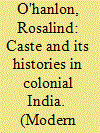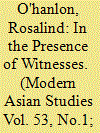| Srl | Item |
| 1 |
ID:
152622


|
|
|
|
|
| Summary/Abstract |
David Washbrook's influential early work on South India set the terms for much subsequent debate about caste, with its exploration of the key role of the colonial state in shaping caste ideologies and institutions. Over subsequent decades, historians and anthropologists have come increasingly to emphasise the ‘colonial construction’ of caste and its enduring legacies in post-colonial India. Yet there were also significant continuities linking the forms of colonial caste with much earlier regional histories of conflict and debate, whose legacies can be traced into the late colonial period. In particular, the juxtaposition between Brahman and non-Brahman itself was anticipated in a tradition of conservative social commentary that emerged in the Deccan Sultanate state of Ahmadnagar, and came to circulate widely through Banaras and western India during the seventeenth and eighteenth centuries. This tradition of commentary acquired new salience during the nineteenth century. It entered the colonial archive as an authoritative source of knowledge, and also provoked early ‘non-Brahman’ intellectuals into a fresh engagement with its conservative social vision. In their attempts to rebut this vision, these intellectuals displayed a detailed knowledge of its social history and a deep familiarity with the judicial decisions through which it had been upheld in earlier centuries.
|
|
|
|
|
|
|
|
|
|
|
|
|
|
|
|
| 2 |
ID:
164870


|
|
|
|
|
| Summary/Abstract |
British observers of the nineteenth-century panchayat were convinced that it represented a judicial forum of great antiquity, in which petitioners were able to gain local and direct access to justice. They contrasted the panchayat favourably with the delays and frustrations that beset the eighteenth-century East India Company's attempts to channel all petitions through its own courts. This article examines the history of the pre-colonial panchayat in western India and its early modern predecessors. During the early modern centuries, a diverse array of state-level and local corporate bodies made up the landscape for the submission of petitions and the hearing of suits. Although many suits were local in nature, the process of hearing and adjudication itself gave these judicial spaces a significant ‘public’ dimension, and their forms of argumentation frequently invoked general principles of justice and moral order. From the early eighteenth century, the new form of the panchayat came to supersede these older corporate bodies and to reshape the forms of public that gathered around them. The Maratha state, based in Pune, sought firmer control over revenue and justice. State officials promoted the panchayat as a new type of judicial arena, weakening the local corporate institutions and tying them more closely to the Pune court.
|
|
|
|
|
|
|
|
|
|
|
|
|
|
|
|